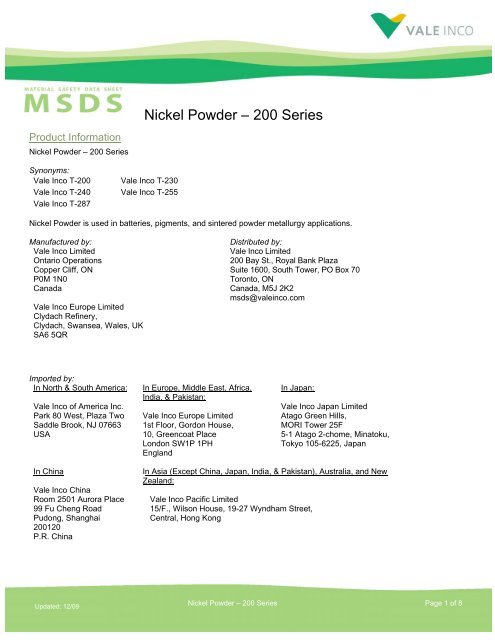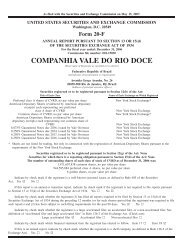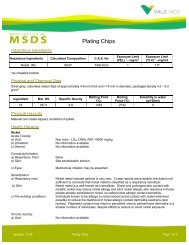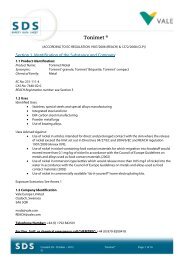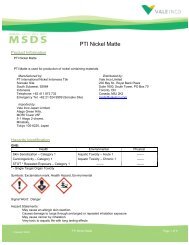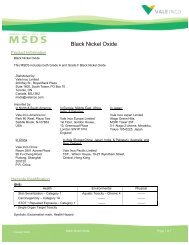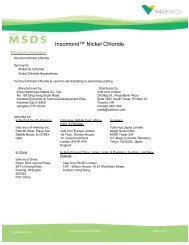Nickel Powder â 200 Series - Vale.com
Nickel Powder â 200 Series - Vale.com
Nickel Powder â 200 Series - Vale.com
You also want an ePaper? Increase the reach of your titles
YUMPU automatically turns print PDFs into web optimized ePapers that Google loves.
<strong>Nickel</strong> <strong>Powder</strong> – <strong>200</strong> <strong>Series</strong><br />
Product Information<br />
<strong>Nickel</strong> <strong>Powder</strong> – <strong>200</strong> <strong>Series</strong><br />
Synonyms:<br />
<strong>Vale</strong> Inco T-<strong>200</strong> <strong>Vale</strong> Inco T-230<br />
<strong>Vale</strong> Inco T-240 <strong>Vale</strong> Inco T-255<br />
<strong>Vale</strong> Inco T-287<br />
<strong>Nickel</strong> <strong>Powder</strong> is used in batteries, pigments, and sintered powder metallurgy applications.<br />
Manufactured by:<br />
<strong>Vale</strong> Inco Limited<br />
Ontario Operations<br />
Copper Cliff, ON<br />
P0M 1N0<br />
Canada<br />
<strong>Vale</strong> Inco Europe Limited<br />
Clydach Refinery,<br />
Clydach, Swansea, Wales, UK<br />
SA6 5QR<br />
Distributed by:<br />
<strong>Vale</strong> Inco Limited<br />
<strong>200</strong> Bay St., Royal Bank Plaza<br />
Suite 1600, South Tower, PO Box 70<br />
Toronto, ON<br />
Canada, M5J 2K2<br />
msds@valeinco.<strong>com</strong><br />
Imported by:<br />
In North & South America:<br />
<strong>Vale</strong> Inco of America Inc.<br />
Park 80 West, Plaza Two<br />
Saddle Brook, NJ 07663<br />
USA<br />
In Europe, Middle East, Africa,<br />
India, & Pakistan:<br />
<strong>Vale</strong> Inco Europe Limited<br />
1st Floor, Gordon House,<br />
10, Greencoat Place<br />
London SW1P 1PH<br />
England<br />
In Japan:<br />
<strong>Vale</strong> Inco Japan Limited<br />
Atago Green Hills,<br />
MORI Tower 25F<br />
5-1 Atago 2-chome, Minatoku,<br />
Tokyo 105-6225, Japan<br />
In China<br />
<strong>Vale</strong> Inco China<br />
Room 2501 Aurora Place<br />
99 Fu Cheng Road<br />
Pudong, Shanghai<br />
<strong>200</strong>120<br />
P.R. China<br />
In Asia (Except China, Japan, India, & Pakistan), Australia, and New<br />
Zealand:<br />
<strong>Vale</strong> Inco Pacific Limited<br />
15/F., Wilson House, 19-27 Wyndham Street,<br />
Central, Hong Kong<br />
Updated: 12/09<br />
<strong>Nickel</strong> <strong>Powder</strong> – <strong>200</strong> <strong>Series</strong> Page 1 of 8
Hazards Identification<br />
GHS:<br />
Health Environmental Physical<br />
Skin Sensitization – Category 1 Aquatic Toxicity – Chronic 3 -------<br />
Carcinogenicity – Category 2 ------- -------<br />
STOT * Repeated Exposure – Category 1 ------- -------<br />
* - Single Organ Target Toxicity<br />
Symbols: Exclamation mark, Health Hazard<br />
Signal Word: Danger<br />
Hazard Statements:<br />
May cause an allergic skin reaction.<br />
Causes damage to lungs through prolonged or repeated inhalation exposure<br />
Suspected of causing cancer<br />
Harmful to aquatic life with long lasting effects<br />
Precautionary Statements:<br />
Prevention:<br />
Avoid breathing dust or fume.<br />
Contaminated work clothing should not be allowed out of the workplace.<br />
Wear protective gloves and protective clothing<br />
Wash hands, and face thoroughly after handling.<br />
Do not eat, drink or smoke when using this product.<br />
Response:<br />
If on skin: Wash with plenty of soap and water.<br />
If skin irritation or rash occurs: Get medical advice/attention.<br />
Get medical advice/attention if you feel unwell.<br />
Disposal:<br />
Dispose of contents/container in accordance to local/regional/national/international regulations<br />
Composition<br />
Substance<br />
Mixture<br />
Hazardous Typical C.A.S. EINECS/<br />
Ingredients Composition Number EC Label No.<br />
<strong>Nickel</strong> Metal (Ni) >98% 7440-02-0 231-111-4<br />
Updated: 12/09<br />
<strong>Nickel</strong> <strong>Powder</strong> – <strong>200</strong> <strong>Series</strong> Page 2 of 8
First Aid Measures<br />
Ingestion<br />
Inhalation<br />
Skin<br />
Eyes<br />
Wounds<br />
Seek medical attention.<br />
Seek medical attention.<br />
Wash thoroughly with water. For rashes seek medical advice. Show label or data sheet if<br />
possible.<br />
Irrigate eyeball thoroughly with water for at least 10 minutes. If dis<strong>com</strong>fort persists seek<br />
medical attention.<br />
Cleanse thoroughly to remove any nickel particles.<br />
Fire Fighting Measures<br />
Suitable extinguishing media:<br />
Special Risks:<br />
Special protective equipment<br />
for fire fighting:<br />
Package intact - Any, type to be selected according to materials stored in the immediate<br />
neighborhood. Spilled <strong>Powder</strong> – Use water mist or fine spray - pressurized extinguishers<br />
may disperse the powder and spread the fire.<br />
Not classified as flammable for transport purposes. May oxidize to nickel oxide if exposed<br />
to high temperatures within a fire. Keep containers cool with water spray.<br />
None needed. Wear protective equipment if required for other materials<br />
within the immediate vicinity<br />
Accidental Release Measures<br />
Person related precautionary<br />
measures:<br />
Environmental protection<br />
measures:<br />
Procedures for cleaning/<br />
absorption:<br />
Avoid generation of dusty atmospheres. Do not inhale dusts.<br />
No specific measures needed<br />
Collect spills by wet sweeping or vacuuming with the vacuum exhaust<br />
passing through a high efficiency particulate arresting (HEPA) filter if exhaust<br />
is discharged into the work place. Wear appropriate nationally approved<br />
respirators if collection and disposal of spills is likely to cause the<br />
concentration limits of airborne nickel to exceed the locally prescribed<br />
exposure limits. <strong>Nickel</strong> containing material is normally collected to recover nickel values.<br />
Handling and Storage<br />
Handling:<br />
Prevent the generation of inhalable dusts e.g. by the use of suitable ventilation. Do not<br />
inhale dusts. Wear appropriate nationally approved respirators if handling is likely to<br />
Updated: 12/09<br />
<strong>Nickel</strong> <strong>Powder</strong> – <strong>200</strong> <strong>Series</strong> Page 3 of 8
cause the concentration limits of airborne nickel to exceed the locally prescribed<br />
exposure limits. Wear suitable protective clothing and gloves. As packed nickel product<br />
may constitute a manual handling risk.<br />
Storage:<br />
Keep in the container supplied, in dry conditions and keep the container closed when not<br />
in use. Containers should be stored under cover in a clean and dry environment. Local<br />
regulations should be followed regarding the storage of this material.<br />
Exposure Controls/Personal Protection<br />
<strong>Nickel</strong> Metal (Ni) – CAS 7440-02-0<br />
Exposure Limit (mg/m3)<br />
Year<br />
ACGIH TLV-TWA 1 1.5 * <strong>200</strong>8<br />
UK WEL 2 0.5 <strong>200</strong>6<br />
Japan 1 1968<br />
Korea 1 <strong>200</strong>6<br />
China 1 <strong>200</strong>7<br />
* - as Ni in inhalable fraction<br />
Maintain airborne nickel levels as low as possible.<br />
Occupational exposure<br />
controls:<br />
Ventilation is normally required when handling or using this product to keep<br />
airborne nickel below the nationally authorized limits. If ventilation alone<br />
cannot control exposure, respiratory protection must be used.<br />
a) Respiratory protection: Do not inhale dust. If ventilation alone cannot control exposure, respiratory<br />
protection (selected specifically for the working place, depending on<br />
concentration and quantity of the hazardous material) must be used.<br />
b) Eye protection: Avoid contact with eyes. Wear goggles or face shield or approved safety glasses.<br />
c) Hand and skin protection: Avoid skin contact. Wear suitable protective clothing and gloves, which should be<br />
selected specifically for the working place, dependant on the concentration and quantity<br />
of the hazardous material being handled. Wash skin thoroughly after handling and<br />
before eating, drinking or smoking. Launder clothing and gloves as needed. Use of skin<br />
protective barrier cream advised.<br />
Updated: 12/09<br />
<strong>Nickel</strong> <strong>Powder</strong> – <strong>200</strong> <strong>Series</strong> Page 4 of 8
Physical and Chemical Properties<br />
Silver grey, odourless metallic powder.<br />
Ingredient Mol. Wt.<br />
<strong>Nickel</strong> 58.71<br />
pH<br />
Not Applicable (N/A)<br />
Boiling point/ boiling range 2732°C<br />
Freezing point / freezing range 1453°C<br />
Flash Point<br />
N/A<br />
Evaporation rate<br />
N/A<br />
Flammability<br />
N/A<br />
Explosive properties<br />
Not explosive<br />
Vapour pressure<br />
N/A<br />
Vapour density<br />
N/A<br />
Relative density<br />
8.9 g/cm3<br />
Solubility cold water<br />
Insoluble<br />
Solubility hot water<br />
Insoluble<br />
Partition coefficient<br />
N/A<br />
Auto-ignition temperature<br />
N/A<br />
De<strong>com</strong>position temperature<br />
N/A<br />
Oxidizing properties<br />
Not oxidizing<br />
Viscosity<br />
N/A<br />
Particle size 2.5 - 8<br />
Bulk density (g/cm3) 1.0 - 3.0<br />
Magnetic properties<br />
Ferromagnetic<br />
Stability and Reactivity<br />
Conditions to be avoided:<br />
Substances to be avoided:<br />
Hazardous de<strong>com</strong>position<br />
products:<br />
Hazardous exothermic reaction improbable. Not classified as flammable.<br />
This product can react vigorously with acids to liberate hydrogen, which can form<br />
explosive mixtures with air. Under special conditions nickel can react with carbon<br />
monoxide in reducing atmospheres to form <strong>Nickel</strong> Carbonyl, Ni(CO) 4 , a toxic gas. Metal<br />
powders when heated in reducing atmospheres may be<strong>com</strong>e pyrophoric.<br />
None<br />
Toxicological Information 3<br />
<strong>Nickel</strong>:<br />
Acute Toxicity:<br />
a) Oral: Non toxic - LD 50 ORAL RAT >9000 mg/kg<br />
Updated: 12/09<br />
<strong>Nickel</strong> <strong>Powder</strong> – <strong>200</strong> <strong>Series</strong> Page 5 of 8
) Inhalation: One case has been reported of a fatality following extreme exposure at an estimated 382<br />
mg Ni/m3. A plasma spraying operative died of pneumonia 13 days after exposure to<br />
nickel powder particles. The post mortem diagnosis was shock lung.<br />
c) Dermal: No information available.<br />
Corrosivity/Irritation:<br />
a) Respiratory Tract: None<br />
b) Skin: See sensitization section.<br />
c) Eyes: Mechanical irritation may be expected.<br />
Sensitization:<br />
a) Respiratory tract: <strong>Nickel</strong> metal induced asthma is very rare. 3 case reports are available; the data is not<br />
sufficient to conclude that nickel metal is classified as a respiratory sensitizer.<br />
b) Skin: <strong>Nickel</strong> metal is a well-known sensitizer. Direct and prolonged skin contact with metallic<br />
nickel may induce nickel allergy and elicit nickel allergic skin reactions in those people<br />
already sensitized to nickel, so called nickel allergic contact dermatitis.<br />
c) Preexisting Conditions: Individuals known to be allergic to nickel should avoid contact with nickel whenever<br />
possible to reduce the likelihood of nickel allergic contact dermatitis reactions (skin<br />
rashes). Repeated contact may result in persistent chronic palmar/hand dermatitis in a<br />
small number of individuals, despite efforts to reduce or avoid nickel exposure.<br />
Repeated dose toxicity:<br />
a) Oral: No information available<br />
b) Inhalation: Animal studies (rats) show that repeated dose inhalation of nickel damages the lung.<br />
Chronic inflammation, lung fibrosis and accumulation of nickel particles were observed.<br />
c) Dermal: Direct and prolonged skin contact with nickel metal may cause nickel sensitization<br />
resulting in nickel allergic contact dermatitis /skin rash.<br />
Mutagenicity /<br />
Reproductive toxicity:<br />
<strong>Nickel</strong> metal powders may act in the body like soluble nickel <strong>com</strong>pounds. Soluble nickel<br />
<strong>com</strong>pounds have been shown to be toxic to reproduction in pregnant female rats causing<br />
“stillbirths”. The relevance of the animal data to human exposure is unknown to date. So<br />
far no human studies confirm this effect.<br />
Carcinogenicity:<br />
a) Ingestion: The U.S. National Institute for Occupational Safety and Health (NIOSH) concluded that<br />
there is no evidence that nickel metal is carcinogenic when ingested.<br />
b) Inhalation: There is limited information available from inhalation and intratracheal studies in animals.<br />
The U.S. National Toxicology Program has listed metallic nickel as reasonably<br />
Updated: 12/09<br />
<strong>Nickel</strong> <strong>Powder</strong> – <strong>200</strong> <strong>Series</strong> Page 6 of 8
anticipated to be a human carcinogen. To date, there is no evidence that nickel metal<br />
causes cancer in humans based on epidemiology data from workers in the nickel<br />
producing and nickel consuming industries.<br />
The International Agency for Research on Cancer (IARC)(Vol 49) found there was inadequate evidence that<br />
metallic nickel is carcinogenic to humans but since there was sufficient evidence that it is carcinogenic to animals,<br />
IARC concluded that metallic nickel is possibly carcinogenic to humans (Group 2B). In 1997, the ACGIH<br />
categorized elemental nickel as: A5 "Not Suspected as a Human Carcinogen". Epidemiological studies of workers<br />
exposed to nickel powder and to dust and fume generated in the production of nickel alloys and of stainless steel<br />
have not indicated the presence of a significant respiratory cancer hazard<br />
Ecological Information<br />
Biologic degradation:<br />
Ecotoxic effects:<br />
Biological data:<br />
Further Ecological Data:<br />
Methods for the determination of biodegradability are not applicable to inorganic<br />
substances.<br />
Non toxic<br />
Fish toxicity Br. rerio LC50>100mg/1/96h;<br />
Daphnia Toxicity: Daphnia magna EC50:>100mg/1/48h;<br />
Algeal Toxicity: Selenastrum capricornatum IC50: 100mg/1/72 (suspension);<br />
Bacterial toxicity: Pseudomonas fluorescens EC50: 250mg/1/48h<br />
Due to poor solubility of the product, no harmful effects on aquatic organisms are to be<br />
expected when handled and used with due care and attention.<br />
Disposal Considerations<br />
<strong>Nickel</strong> containing material is normally collected to recover nickel values. Should disposal be deemed necessary follow<br />
local regulations.<br />
Transport Information<br />
International Maritime Dangerous<br />
Goods Code<br />
International Civil Aviation<br />
Organization Technical Instructions<br />
for the Carriage of Dangerous Goods<br />
by Air<br />
U.S. Dept. of Transportation<br />
Regulations<br />
Canadian Transportation of<br />
Dangerous Goods Act<br />
European Agreement Concerning the<br />
International Carriage of Dangerous<br />
Goods by Road<br />
Not Regulated.<br />
Not Regulated.<br />
Apply to nickel powders if they are less than 100<br />
micron in particle size and if they are packaged in<br />
quantities greater than 100 pounds.<br />
Not Regulated.<br />
Not Regulated.<br />
Updated: 12/09<br />
<strong>Nickel</strong> <strong>Powder</strong> – <strong>200</strong> <strong>Series</strong> Page 7 of 8
Regulatory Information<br />
Other Information<br />
Note:<br />
<strong>Vale</strong> Inco believes that the information in this Material Safety Data Sheet is accurate. However, <strong>Vale</strong> Inco makes no express or<br />
implied warranty as to the accuracy of such information and expressly disclaims any liability resulting from reliance on such<br />
information.<br />
1. Threshold Limit Values of the American Conference of Governmental Industrial Hygienists. <strong>200</strong>8.<br />
2. Maximum Exposure Limit of the Health and Safety Executive in the U.K. in EH40/00.<br />
3. Describes possible health hazards of the product supplied. If user operations change it to other chemical forms,<br />
whether as end products, intermediates or fugitive emissions, the possible health hazards of such forms must be<br />
determined by the user.<br />
Safety Data Sheet prepared by:<br />
<strong>Vale</strong> Inco Limited<br />
<strong>200</strong> Bay St., Royal Bank Plaza<br />
Suite 1600, South Tower, PO Box 70<br />
Toronto, ON<br />
Canada, M5J 2K2<br />
Product Stewardship (416) 361-7801<br />
msds@valeinco.<strong>com</strong><br />
SDS available online at www.valeinco.<strong>com</strong><br />
Updated: 12/09<br />
<strong>Nickel</strong> <strong>Powder</strong> – <strong>200</strong> <strong>Series</strong> Page 8 of 8


